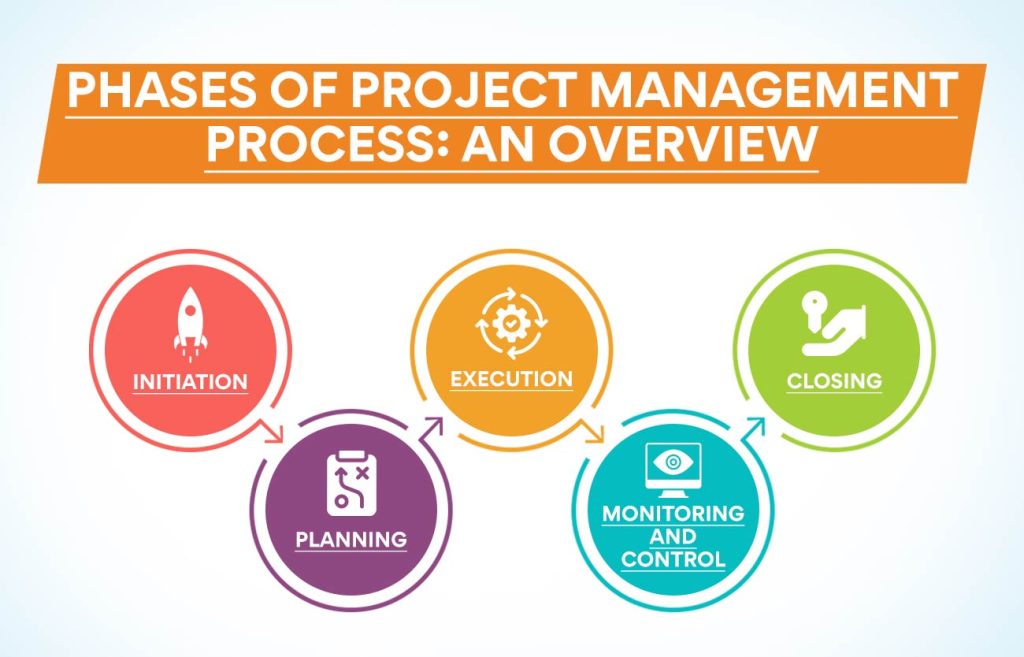Project management training is the use of particular information, skills, tools, and procedures. Project management provides people with something of value. Projects include things like building and providing relief following a natural disaster. It also entails expanding sales and developing software for better company processes.
This project management training will enable your employees to get skills, knowledge, and experience. They will be able to apply them to achieve particular project objectives. Under the project criteria, your firm will benefit from this project management training.
Project Management Training Cycle
The project management training lifecycle will offer you guidance when it comes to projects. It is a step-by-step structure of best practices. It offers project managers a methodical way to plan, carry out, and complete a project.
The phases project management training process will include: –
- The initiation phase
- Project planning phase
- The execution phase
- Project monitoring and evaluation phase
- The closing phase
Between the execution and closing phases, some may forget the “monitoring and controlling” stage even though it is a vital phase in project management training. However, a project team boosts its chances of success by following each stage.
The project management lifecycle gives initiatives structure to increase their likelihood of success. It’s a procedure you should be well-versed in as a project manager.
Through the project management training, this the cycle you will follow:
1. Project initiation phase
In this is the first project management phase where you will establish the project. This means you have to determine the project’s objectives, scope, available resources, and team member roles. The team should have a clear direction if stakeholders’ expectations are made explicit. This is along with the specific goals of the project and their justifications.
The success of the project depends on this stage. A project should be clear about what it must be accomplished and why. This reduces the risk of a project failing to meet stakeholders’ expectations.
The following are some of the phases of initiation:
- Team size and roles to be confirmed
- Interacting with stakeholders to ensure that they know the project’s goals and intended results
- Defining the project’s scope
- Deciding who the project’s stakeholders will be and how they will take part
- Assembling a project charter and proposal
- Setting SMART objectives (specific, measurable, achievable, relevant, and time-bound)
- Defining resources, such as spending limits and deadlines
Initiation phase tools and documents may include: –
Project proposal:
A project proposal specifies a project and lists important deadlines, specifications, and objectives.
Project charter:
This comprehensive document outlines the project and information required to achieve its objectives. This can cover potential dangers, advantages, restrictions, and important stakeholders.
RACI chart:
A project team’s members’ roles and duties are shown on a RACI chart.
2. Project planning phase
You’ll decide the steps to finish the project goals during the second project management phase, the planning phase. This works like a roadmap for your project.
You’ll set up spending limits, deadlines, checkpoints, sources, and required paperwork. This step entails estimating and forecasting risk. It also involves implementing change management procedures and laying out communication guidelines.
In addition, you can also choose your troops in the planning phases. This is equal to gathering your forces during the initiation phase.
The following actions can be part of the planning phase:
- Choosing the milestones that will help you reach your goal
- Creating time estimates and potential time allowances for tasks and milestones
- Putting in place change processes
- Making a risk register of risk assessment and management
- Launching a project by holding a kick-off meeting
- Deciding on a communication strategy and frequency with the team and stakeholders
- Drafting and signing documents like requests for proposals or non-disclosure agreements.
- Choosing the milestones that will help you reach your goal
In this phase, you might use the following tools:
- A Gantt chart that highlights project-related risks along with potential impact and mitigation strategies. With this member can see what tasks must be performed in what sequence.
- A risk management plan
- Communication plan
- Stakeholder management plan
- Work schedule
3. Project execution phase
A project’s execution entails carrying out your plan and directing the crew. For the most part, this third project management phase includes monitoring and measuring progress and maintaining quality. It can entail reducing risk, managing the budget, and using data to guide your decisions.
Possible actions in detail are:
- Keeping everyone involved in the process informed
- Incorporating modifications through change requests
- Taking action when hazards present themselves
- Tracking expenses
- Maintaining the focus and motivation of the squad
4. Project monitoring and evaluation phase
This fourth project management phase often works concurrently with the execution phase. It entails keeping an eye on how the project execution tasks are going so as to make sure the project team remains on track and within budgetary constraints.
Another essential component of this project management phase is evaluation. Project managers can use it to monitor achievements in the first place, and stakeholders can receive updates during briefings by using the data it delivers.
5. Project closing phase
You’ll wrap up project activities during the last cycle of the project management phase. You will hand the final good or service on to the new owners, and check what went well and what didn’t. It will also be an occasion to recognize your efforts.
A few possible closing phase actions are:
- Conducting retrospectives and making notes of adjustments you can make later
- Letting stakeholders know when the project is finished and distributing an impact report
- Interacting with a project’s new owners.
Monitoring and evaluation
Project evaluation refers to gathering, logging, and organizing information about project outcomes. It includes employing short-term, immediate, and long-term project outputs to achieve outcomes.
The following are typical justifications for conducting an evaluation:
- Meeting accountability demands
- Demonstrating effective, efficient, and fair use of financial and other resources
- Recognizing actual changes and progress made
- Identifying success areas that need improvement, or instances where expected results are unrealistic
- Reassuring project staff and partners that desired outcomes are being achieved
During the planning stage, you can specify the intended outcomes and how to measure them. This guarantees that information needed to gauge success is available. when it comes time to assess the project.
The evaluation of a project is predicated on a thorough analysis of the project as a whole.
The success or failure of a project is determined by how well it meets its goals as a whole. The evaluation procedure leads to improved policy and execution.
In the majority of government planning agencies, it has not yet become institutionalized.
Project planning entails establishing evaluation standards, criteria, and indicators. You can do this within the first phases of the project planning process. Locating and gathering baseline data entails the following specifications: –
Identification of assessment criteria
These are the main outcome areas that are measurable and include terms of cost, budget constraints, productivity output, and targets.
Choosing assessment procedures
You can choose cost-benefit analysis, baseline measurements, sampling, and different data collection techniques. Additionally, you can also include field surveys, focus groups, questionnaires, and interviews.
Timetable
Arrange project evaluation when findings are not clear on project completion.
Budget for evaluation
It is important to plan for the effective use of the resources that the evaluation will require.
Organization and personnel needs
Be specific with the size of the evaluation team and staff access to project material.



